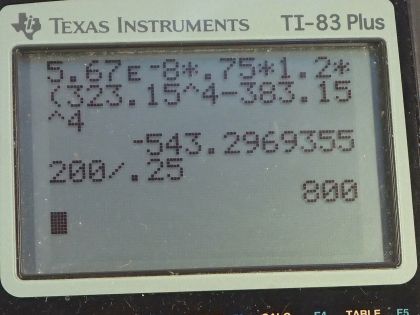Question
(a) Calculate the rate of heat transfer by radiation from a car radiator at into a environment, if the
radiator has an emissivity of 0.750 and a surface
area. (b) Is this a significant fraction of the heat transfer by an automobile engine? To answer this, assume a horsepower of 200 hp and the efficiency of automobile engines as 25%.
Final Answer
- Only about 0.12% of heat is transferred from the radiator by radiation. Most heat is transferred by conduction to cold air blown through the radiator by a fan.
Solution video
OpenStax College Physics, Chapter 14, Problem 58 (Problems & Exercises)

vote with a rating of
votes with an average rating of
.
Calculator Screenshots
Video Transcript
This is College Physics Answers with Shaun Dychko. A car radiator is at a temperature of 110 degrees Celsius which we convert into Kelvin by adding 273.15. It's emitting radiation into the environment to dissipate some heat which is at a temperature of 50.0 degrees Celsius so underneath the hood, in other words, is 50.0 degrees Celsius. The emissivity of the radiator is 0.750 and its area is 1.20 square meters. So part (a) asks us what is the rate of heat transfer by radiation? So that's gonna be Stefan-Boltzmann's constant multiplied by the emissivity times the area times the temperature of the environment to the power of 4 minus the temperature of the radiator to the power of 4. So it's 5.67 times 10 to the minus 8 times 0.750 emissivity times 1.20 square meters area times 323.15 Kelvin to the power of 4 minus 383.15 Kelvin to the power of 4 and this makes a rate of heat transfer of negative 543 watts— the negative sign indicating that the radiator is losing heat to the environment as it's meant to do. In part (b), we are asked to figure out what fraction of the total heat energy produced by the engine is being dissipated by radiative heat transfer from the radiator? So the efficiency of the engine is the power output divided by the power input and the power output is the horse power rating of the engine— 200 horsepower— and we can solve for the total rate of energy consumption of the engine by solving for P in so we multiply both sides by P in divided by efficiency. So the power input is the power output divided by efficiency so that's 200 horsepower divided by 0.25 which is 800 horsepower. What we really want to know is the rate of heat production by the engine so that will be the difference between the total rate of energy consumed, 800 horsepower, minus the power that is output usefully as mechanical power, which is 200 horsepower and so that difference is 600 horsepower and so this is the rate of heat production. And we'll convert that into watts by multiplying by 746 watts per horsepower so that's 4.476 times 10 to the 5 watts. So we'll figure out what fraction the radiative heat transfer is as a fraction of the total heat production and so 546 watts divided by 4.476 times 10 to the 5 watts is 0.00122. So only 0.12 percent of the heat produced by the engine is transferred from the radiator by radiation. Most heat is transferred from the radiator by conduction to the cold air that's blown through the radiator by a fan.

